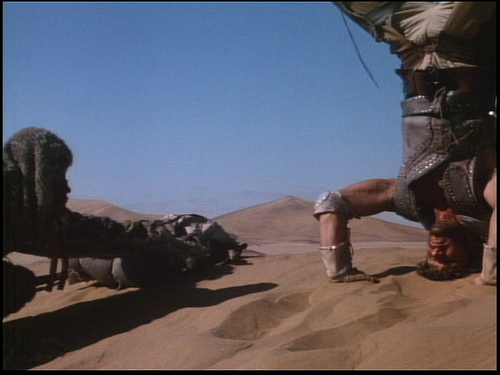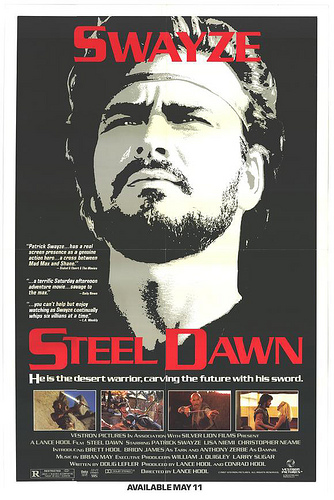 As a youth I used to live in the shelves of my local video store. Most summers I would spend my days down at the local strip mall (a scant 1.3 miles away) bowling for hours, reading comics off the rack at the drug store, picking out the most essential candy at the grocery store and finally wandering in the stacks, searching for the perfect movie to watch that weekend. All this time spent in the stacks lead to a curious skill of recognizing films based solely by their cover art, and I’d often know the plot of the films based off of the descriptions on the back. Soon it became a bit of a game for my friends to quiz me on what the films were about, but only the films I’d never actually seen and using simply the cover as a hint.
As a youth I used to live in the shelves of my local video store. Most summers I would spend my days down at the local strip mall (a scant 1.3 miles away) bowling for hours, reading comics off the rack at the drug store, picking out the most essential candy at the grocery store and finally wandering in the stacks, searching for the perfect movie to watch that weekend. All this time spent in the stacks lead to a curious skill of recognizing films based solely by their cover art, and I’d often know the plot of the films based off of the descriptions on the back. Soon it became a bit of a game for my friends to quiz me on what the films were about, but only the films I’d never actually seen and using simply the cover as a hint.
Of course, back then I was still very young and simply didn’t have the time nor the resources to watch every film I wanted to. So I would pick and choose which I would watch, often leaning heavily towards science fiction and fantasy films (my horror obsession didn’t really kick in until my early twenties). So how is it that I never watched a post-apocalyptic film about a nomadic swordsman? Simple, I hated the cover.
After the fallout of World War III the world’s water has become contaminated, leading to sparse populations of humans fighting over what little supplies remain. When a local baron (Anthony Zerbe) seizes the town of Meridian’s only supply of water, they fight back the only way they know how, by hiring a former soldier named Nomad (Patrick Swayze). But Nomad has another reason for being in Meridian, that of finding the assassin who killed his mentor, and who seems to now be making his living as the baron’s resident enforcer.
 To say Steel Dawn starts with a bang and ends with a whimper is a bit of a misnomer. Steel Dawn opens with a face melter. That’s right, a scene so amazing that it will melt your face right off. The problem is, the scene achieves such great heights that the rest of the film pales in comparison. Which is a shame, as Steel Dawn is a damn solid, if a bit predictable, movie.
To say Steel Dawn starts with a bang and ends with a whimper is a bit of a misnomer. Steel Dawn opens with a face melter. That’s right, a scene so amazing that it will melt your face right off. The problem is, the scene achieves such great heights that the rest of the film pales in comparison. Which is a shame, as Steel Dawn is a damn solid, if a bit predictable, movie.
For those at home wondering just what occurs in the opening minutes allow me to indulge you. The film opens with Patrick Swayze standing on his head. Let me repeat, the film opens with Patrick Swayze standing on his head. Why? I have no idea, as the film never even attempts to answer it, but one can only imagine that he does it as some sort of calming technique. Now as he is standing on his head, he just so happens to be in the middle of a desert. A desert teaming with Sand People.
Now by Sand People I do mean people who literally live in the sand, for as our capsized hero coyly looks on, we see the sand begin to move and within a few seconds people begin to emerge. Unlike in modern day films when this would have been done with CGI this was all done wit practical effects. Meaning, they drove out to the middle of some desert, covered two dozen people in rags and then buried them alive. How freaking awesome is that?
 But that alone isn’t the reason why the scene works as well, its that once Swayze chooses to engage these Tusken Raiders (Don’t believe me? Check out those Gaffe sticks they’re wielding.) the film totally goes for broke. Swayze breaks out karate, and what appears to be some sort of pirouette, and when the Tusken Raiders try to steal his backpack he sprints down the dune, dives and in midair does a somersault quite possibly just because it looks cool. But once he reaches his pack he draws a sword and promptly hacks his underground assailant’s arm clean off.
But that alone isn’t the reason why the scene works as well, its that once Swayze chooses to engage these Tusken Raiders (Don’t believe me? Check out those Gaffe sticks they’re wielding.) the film totally goes for broke. Swayze breaks out karate, and what appears to be some sort of pirouette, and when the Tusken Raiders try to steal his backpack he sprints down the dune, dives and in midair does a somersault quite possibly just because it looks cool. But once he reaches his pack he draws a sword and promptly hacks his underground assailant’s arm clean off.
But that’s not all. After slaughtering a dozen of these would be thieves one finally tries to burrow underneath him and drag Nomad below the sand, to which he counters by jamming his sword into the sand, killing the raider and causing blood to spurt out as if it were Texas tea. It truly is an outstanding ten minute action sequence and one hell of a way to open a film, especially considering that I expected Steel Dawn to be more of a slow burn dramatic film rather then the action film it now appeared to be.
The problem is that Steel Dawn is a slow burn styled dramatic film. Point of fact, Steel Dawn is actually a remake of Shane, which becomes quite evident when Swayze makes it to a small settlement, where he finds it is being dominated by a rather nefarious rancher who wishes to control the only water supply in the entire valley. Now Shane is a fine film, one I’ve grown to enjoy more and more over the years, but Steel Dawn is a surprisingly faithful adaptation of this beloved source material. Outside of the futuristic setting, Steel Dawn stays close to the original film.
 A similar concept was used with Outland, which was a remake of High Noon but set in space. And while it also stayed close to the original film it works much better for Outland. I suppose you could argue that Outland was working with better source material, but that would be a hard argument to win as both films are considered classics of the Western genre. And while any ambiguity in Shane’s ending has been scrubbed out of Steel Dawn, the new ending still works quite well and certainly isn’t an issue that hampers the film. So I am left with only one conclusion on why Steel Dawn wasn’t as successful as it should have been; the opening scene should have been cut.
A similar concept was used with Outland, which was a remake of High Noon but set in space. And while it also stayed close to the original film it works much better for Outland. I suppose you could argue that Outland was working with better source material, but that would be a hard argument to win as both films are considered classics of the Western genre. And while any ambiguity in Shane’s ending has been scrubbed out of Steel Dawn, the new ending still works quite well and certainly isn’t an issue that hampers the film. So I am left with only one conclusion on why Steel Dawn wasn’t as successful as it should have been; the opening scene should have been cut.
The most obvious problem with the opening sequence is that it potentially misrepresents the film by leading the uninitiated into believing that they are about to witness a rip-roaring sci-fi action film rather than the drama it truly is. Because of this rapid change in style and pace it gives viewers the false impression that there are pacing issues with Steel Dawn and this can lead directly to impatience while people view the film. It pains me to say this, but the opening scene to Steel Dawn should have been cut for two reasons:
 First, the obvious uneven and disjointed feel between the opening scene and the rest of the film. While the first scene is fantastic, it simply doesn’t fit stylistically with the rest of the movie. So even though it is a great scene, it harms the overall presentation. Which brings me to my second point. Despite it being the best scene in the film, Steel Dawn would be a better film without it.
First, the obvious uneven and disjointed feel between the opening scene and the rest of the film. While the first scene is fantastic, it simply doesn’t fit stylistically with the rest of the movie. So even though it is a great scene, it harms the overall presentation. Which brings me to my second point. Despite it being the best scene in the film, Steel Dawn would be a better film without it.
But how is that possible? Well, besides clearing up the botched transition, by removing the initial scene it gives Nomad an air of mystery. You would have no knowledge of who he is, how skilled he is or even if he is a decent person. The obvious parallel would be Sanjuro (Toshiro Mifune) in Yojimbo. And while Steel Dawn never attempts to play two sides against the middle, the film would be aided by the extra layer of complexity and ambiguity. Of course, they could always go the other way and just cut everything else out and follow the lead of the opening scene. But I’ve already got plenty of fantasy epics to choose from, so I’d rather that Steel Dawn try to be the best post-apocalyptic Western that it can be.
 But wait? What does the cover have to do with any of this? Well that’s simple enough. The cover/poster of Steel Dawn was quite clearly a shameless rip-off of The Running Man. Both used head shots of their stars in a rather distinct sepia tone, and both used giant red script to advertise their star’s last names and the title of the film. Now, to be fair, I have absolutely no idea which film came out first or who stole from whom. But I had seen The Running Man, and it was awesome. And my twelve year old brain put things pretty simply, why would I watch a rip-off of The Running Man when I could just watch The Running Man? For years I thought that way, and it wasn’t until Sawyze’s death that I finally decided to take the plunge and watch Steel Dawn. By last count I think I’ve watched The Running Man 438 times. But now, after finally taking the time to evaluate Steel Dawn, that gap just might be closed a bit.
But wait? What does the cover have to do with any of this? Well that’s simple enough. The cover/poster of Steel Dawn was quite clearly a shameless rip-off of The Running Man. Both used head shots of their stars in a rather distinct sepia tone, and both used giant red script to advertise their star’s last names and the title of the film. Now, to be fair, I have absolutely no idea which film came out first or who stole from whom. But I had seen The Running Man, and it was awesome. And my twelve year old brain put things pretty simply, why would I watch a rip-off of The Running Man when I could just watch The Running Man? For years I thought that way, and it wasn’t until Sawyze’s death that I finally decided to take the plunge and watch Steel Dawn. By last count I think I’ve watched The Running Man 438 times. But now, after finally taking the time to evaluate Steel Dawn, that gap just might be closed a bit.
Just let me watch The Running Man one more time. Then, I promise to even the odds a bit.
